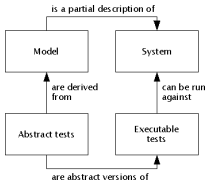Main menu
Tool Scope
Testing Methods
Testing Objectives
- API-testing
- Application-Life-Cycle-Tracking
- Application-Logic-Testing
- Back-End-Service
- Back-end-Stress
- Banking-Process-validation
- Big-Data-Testing
- Binary-Static-Analysis
- Binding-Unit-Testing
- Code-Analysis
- Code-Coverage-testing
- Code-Review
- Code-Tracability
- Coding-Standards-verfication
- Cross-Platform-Testing
- Cross-Browser-testing
- Data-Flow-Analysis
- Data-Interface-Testing
- Data-Migration-Testing
- Data-Warehouse-Testing
- DataBase-testing
- Database-Upgrade-Testing
- Desktop-testing
- EMail-Testing
- Embedded--Software
- ETL-Testing
- Http-Unit-Testing
- Image-Based-Testing
- Image-Comparison
- Interoperability-testing
- Java-testing
- Load-Capabilities
- Log-Tracking
- Memory-Analysis
- Memory-Leak-Detection
- Message-testing
- Metrics-Analysis
- Mobile-Testing
- Network-testing
- Object-Based-Testing
- OWASP-Top10-Testing
- Pair-Wise-Analysis
- Payload-Validation
- Penetration-testing
- Performance-Analysis
- Plugin-testing
- Protocol-Testing
- Runtime-Error-Detection
- SANS-CWE-Top25
- SAP-Testing
- Security-Testing
- SEO
- Server-testing
- SOA-testing
- Static-Code-Analysis
- Stress-Testing
- Test-Cases-Statistics
- Test-Design
- Test-Embedded-systems
- UI-testing
- Uptime-Testing
- WCF-services
- Web-Monitoring
- Web-Services
- Web-testing
- Website-Speed-Testing
You are here
Model Based Testing
Model-based testing is the application of Model based design for designing and executing the necessary artifacts to perform software testing. This is achieved by having a model that describes all aspects of the testing data, mainly the test cases and the test execution environment. Usually, the testing model is derived in whole or in part from a model that describes some (usually functional) aspects of the system under test (SUT).

General model-based testing setting
The model describing the SUT is usually an abstract, partial presentation of the system under test's desired behavior. The test cases derived from this model are functional tests on the same level of abstraction as the model. These test cases are collectively known as the abstract test suite. The abstract test suite cannot be directly executed against the system under test because it is on the wrong level of abstraction. Therefore an executable test suite must be derived from the abstract test suite that can communicate with the system under test. This is done by mapping the abstract test cases to concrete test cases suitable for execution. In some model-based testing tools, the model contains enough information to generate an executable test suite from it. In the case of online testing (see below), the abstract test suite exists only as a concept but not as an explicit artifact.
There are many different ways to "derive" tests from a model. Because testing is usually experimental and based on heuristics, there is no one best way to do this. It is common to consolidate all test derivation related design decisions into a package that is often known as "test requirements", "test purpose" or even "use case". This package can contain e.g. information about the part of the model that should be the focus for testing, or about the conditions where it is correct to stop testing (test stopping criteria).
- Log in to post comments
MANUFACTURERS Wallboard
Theme by Danetsoft and Danang Probo Sayekti
